
The Mosaic Company Moderator: Gagnon, Laura August 7, 2018 08:00 AM CT Operator: Good morning, ladies and gentlemen and welcome to The Mosaic Company Second Quarter 2018 Earnings Conference Call. At this time, all participants have been placed in a listen only mode. After the Company completes their prepared remarks, the lines will be open to take your questions. Your host for today's call is Laura Gagnon, Vice President Investor relations of The Mosaic Company. Ms. Gagnon, you may begin. Laura Gagnon: Thank you and welcome to our second quarter 2018 earnings call. Presenting today, will be Joc O'Rourke, President, and Chief Executive Officer. We also have other members of the senior leadership team available to answer your questions after our prepared remarks. The presentation slides we are using during the call are available on our website at Mosaicco.com. We will be making forward looking statements during this conference call. The statements include but are not limited to statements about future financial and operating results. They are based on management's beliefs and expectations as of today's date and are subject to significant risks and uncertainties. Actual results may differ materially from projected results. Factors that could cause actual results to differ materially from those in the forward looking statements are included in our press release issued yesterday and in our reports filed with the securities and exchange commission. We will also be presenting certain non GAAP financial measures.
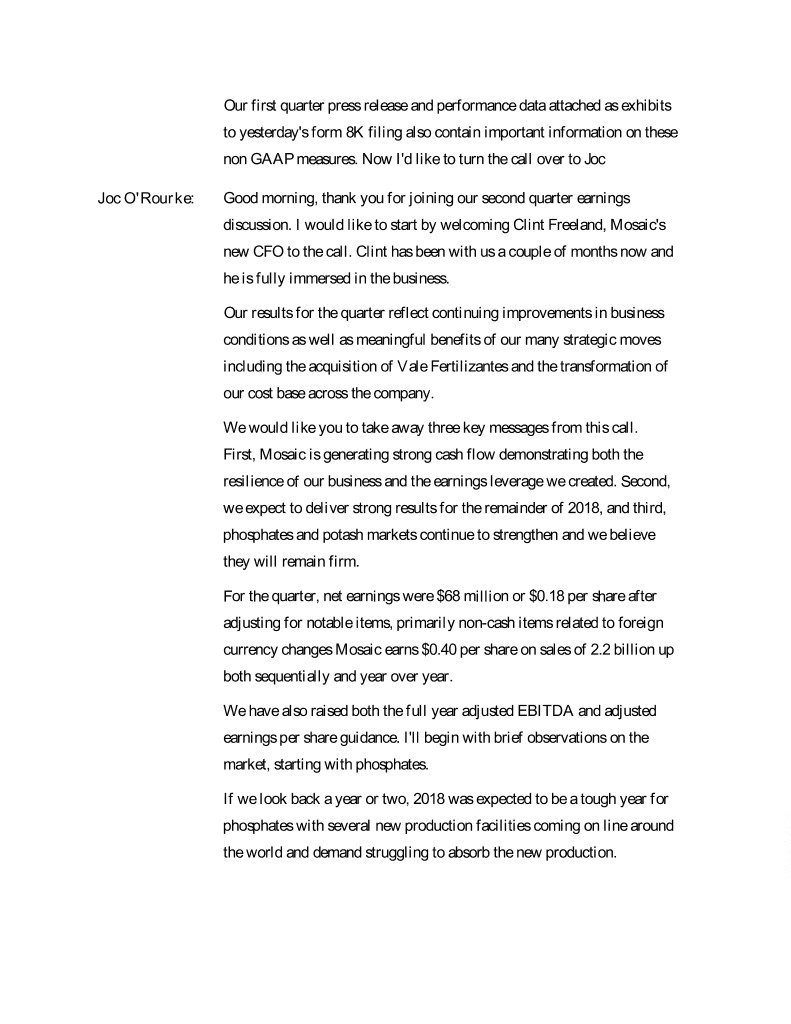
Our first quarter press release and performance data attached as exhibits to yesterday's form 8K filing also contain important information on these non GAAP measures. Now I'd like to turn the call over to Joc Joc O'Rourke: Good morning, thank you for joining our second quarter earnings discussion. I would like to start by welcoming Clint Freeland, Mosaic's new CFO to the call. Clint has been with us a couple of months now and he is fully immersed in the business. Our results for the quarter reflect continuing improvements in business conditions as well as meaningful benefits of our many strategic moves including the acquisition of Vale Fertilizantes and the transformation of our cost base across the company. We would like you to take away three key messages from this call. First, Mosaic is generating strong cash flow demonstrating both the resilience of our business and the earnings leverage we created. Second, we expect to deliver strong results for the remainder of 2018, and third, phosphates and potash markets continue to strengthen and we believe they will remain firm. For the quarter, net earnings were $68 million or $0.18 per share after adjusting for notable items, primarily non-cash items related to foreign currency changes Mosaic earns $0.40 per share on sales of 2.2 billion up both sequentially and year over year. We have also raised both the full year adjusted EBITDA and adjusted earnings per share guidance. I'll begin with brief observations on the market, starting with phosphates. If we look back a year or two, 2018 was expected to be a tough year for phosphates with several new production facilities coming on line around the world and demand struggling to absorb the new production.
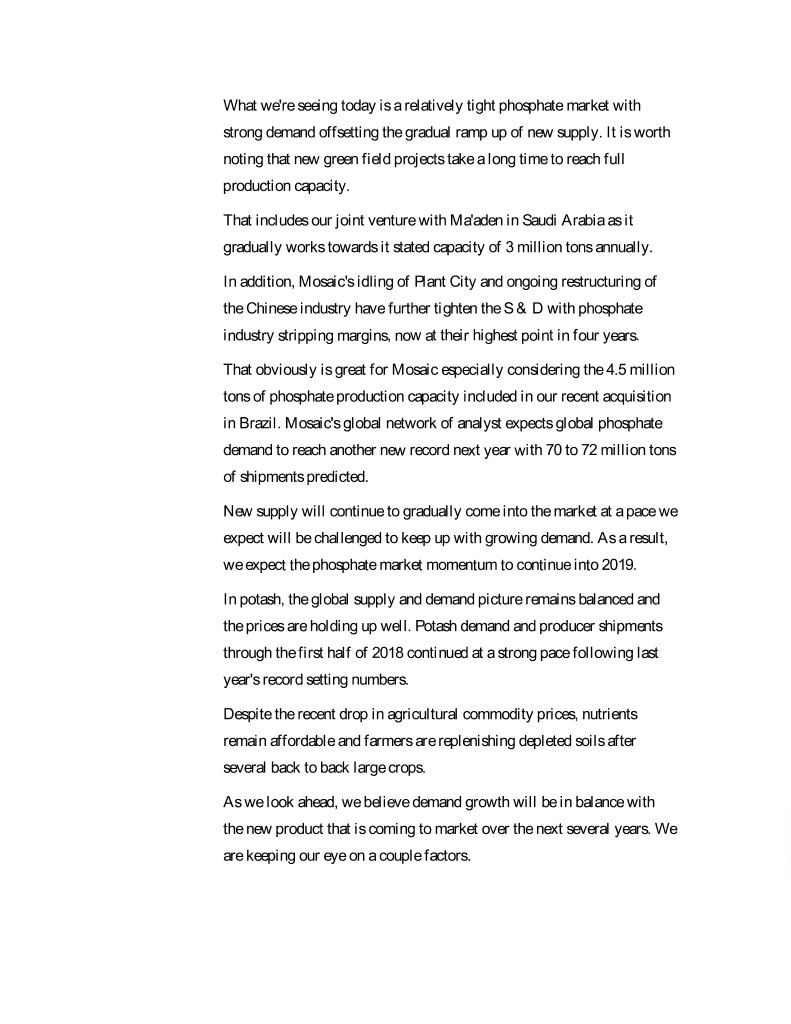
What we're seeing today is a relatively tight phosphate market with strong demand offsetting the gradual ramp up of new supply. It is worth noting that new green field projects take a long time to reach full production capacity. That includes our joint venture with Ma'aden in Saudi Arabia as it gradually works towards it stated capacity of 3 million tons annually. In addition, Mosaic's idling of Plant City and ongoing restructuring of the Chinese industry have further tighten the S & D with phosphate industry stripping margins, now at their highest point in four years. That obviously is great for Mosaic especially considering the 4.5 million tons of phosphate production capacity included in our recent acquisition in Brazil. Mosaic's global network of analyst expects global phosphate demand to reach another new record next year with 70 to 72 million tons of shipments predicted. New supply will continue to gradually come into the market at a pace we expect will be challenged to keep up with growing demand. As a result, we expect the phosphate market momentum to continue into 2019. In potash, the global supply and demand picture remains balanced and the prices are holding up well. Potash demand and producer shipments through the first half of 2018 continued at a strong pace following last year's record setting numbers. Despite the recent drop in agricultural commodity prices, nutrients remain affordable and farmers are replenishing depleted soils after several back to back large crops. As we look ahead, we believe demand growth will be in balance with the new product that is coming to market over the next several years. We are keeping our eye on a couple factors.

First, Chinese phosphate exports have fallen year to date in part because of new environmental restrictions on industrial facilities in China, but as market prices and stripping margins rise and the Chinese currency weakens, producers there may respond by resuming higher export levels. Longer term, we continue to expect high costs Chinese producers to balance the market which is a positive for Mosaic as a vertically integrated producer. Second, agricultural commodity prices are in flux while we will continue to closely monitor these developments and assess their potential impact on global P & K shipments. At this point however, demand prospects look strong in our two key geographies. Soybean economics are highly profitable in Brazil due to weaker REI and a record local basis. In North America, farmers are expected to harvest another large crop about a month earlier than normal and that means they will have ample time to replenish the record amounts of P & K taken out of the field this fall. Now, I'll move on and provide some insight into our business segments. First, in the phosphates business unit we generated gross margin of $67 per ton or $70 per ton after notable items more than double the same quarter a year ago. Margins obviously benefited from higher market prices for our product. Just as important though, is the progress we're making towards transforming this business unit. As an example, even with a significantly higher percentage of Miski Mayo rock consumed during the quarter our phosphate rock costs remain below $60 per ton.
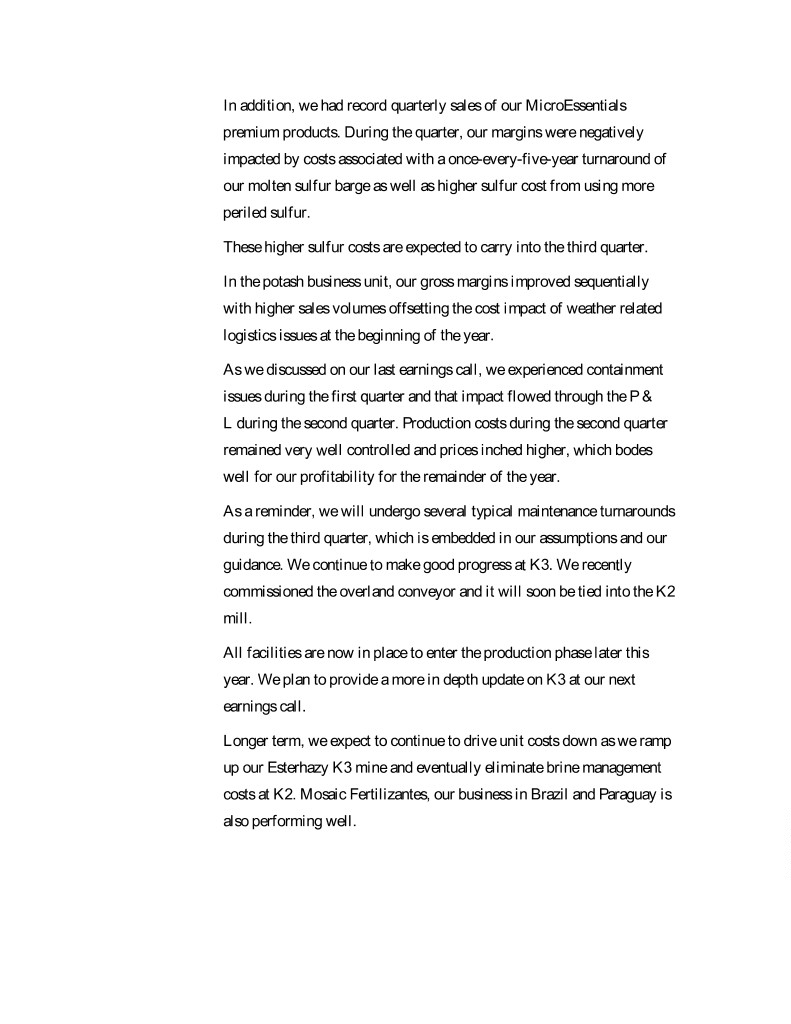
In addition, we had record quarterly sales of our MicroEssentials premium products. During the quarter, our margins were negatively impacted by costs associated with a once-every-five-year turnaround of our molten sulfur barge as well as higher sulfur cost from using more periled sulfur. These higher sulfur costs are expected to carry into the third quarter. In the potash business unit, our gross margins improved sequentially with higher sales volumes offsetting the cost impact of weather related logistics issues at the beginning of the year. As we discussed on our last earnings call, we experienced containment issues during the first quarter and that impact flowed through the P & L during the second quarter. Production costs during the second quarter remained very well controlled and prices inched higher, which bodes well for our profitability for the remainder of the year. As a reminder, we will undergo several typical maintenance turnarounds during the third quarter, which is embedded in our assumptions and our guidance. We continue to make good progress at K3. We recently commissioned the overland conveyor and it will soon be tied into the K2 mill. All facilities are now in place to enter the production phase later this year. We plan to provide a more in depth update on K3 at our next earnings call. Longer term, we expect to continue to drive unit costs down as we ramp up our Esterhazy K3 mine and eventually eliminate brine management costs at K2. Mosaic Fertilizantes, our business in Brazil and Paraguay is also performing well.

The previously published pro formas showed the business was about break even on adjusted EBITDA basis during the second quarter of last year. This year, we generated $55 million of adjusted EBITDA. Some of the improvement came from favorable currency exchange rates and higher phosphate prices, but much of the improvement resulted from the work we are doing to transform the business. Our results in Brazil for the second quarter were negatively impacted by almost $40 million for both plan turn arounds and the nationwide trucker strike in May. As a result of the strike, we idled production and lost shipment volumes which caused us to miss our volume guidance for the quarter. In total, we estimate the strike lowered adjusted earnings by approximately $11 million before tax. We're continuing to monitor the situation closely as the government and the truckers work to find a more lasting resolution. Regardless, we believe our position at the low end of the delivered cost curve gives us a competitive advantage in Brazil. The teams in Brazil are well ahead of schedule to achieve $100 million in net savings this year and 275 million by the end of 2020. They are executing several hundred projects from labor efficiencies, to mine process improvements, and increased chemical plant through put. Year to date, $56 million of gross synergies or $34 million, after cost to achieve, have hit the bottom line. As an example, we are pleased to see that costs at our Tapira mine have already been reduced by almost 30% on a Real basis. While we believe it is likely, we will achieve net synergies in excess of $100 million in 2018 there is still much to be done.
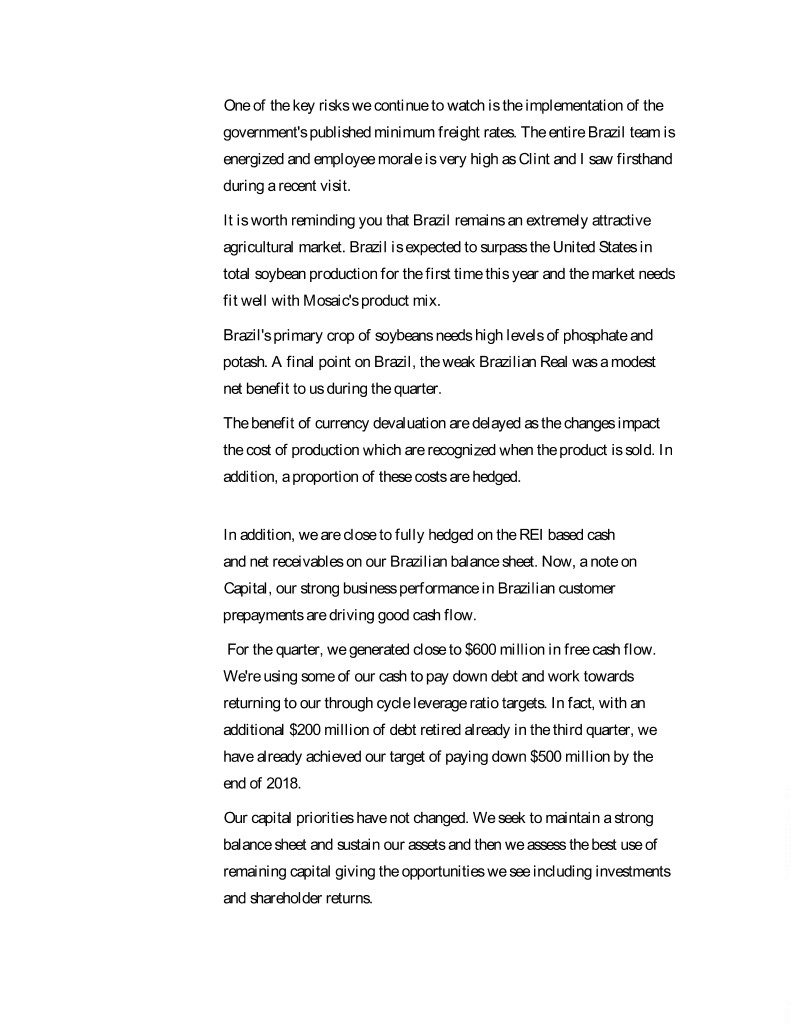
One of the key risks we continue to watch is the implementation of the government's published minimum freight rates. The entire Brazil team is energized and employee morale is very high as Clint and I saw firsthand during a recent visit. It is worth reminding you that Brazil remains an extremely attractive agricultural market. Brazil is expected to surpass the United States in total soybean production for the first time this year and the market needs fit well with Mosaic's product mix. Brazil's primary crop of soybeans needs high levels of phosphate and potash. A final point on Brazil, the weak Brazilian Real was a modest net benefit to us during the quarter. The benefit of currency devaluation are delayed as the changes impact the cost of production which are recognized when the product is sold. In addition, a proportion of these costs are hedged. In addition, we are close to fully hedged on the REI based cash and net receivables on our Brazilian balance sheet. Now, a note on Capital, our strong business performance in Brazilian customer prepayments are driving good cash flow. For the quarter, we generated close to $600 million in free cash flow. We're using some of our cash to pay down debt and work towards returning to our through cycle leverage ratio targets. In fact, with an additional $200 million of debt retired already in the third quarter, we have already achieved our target of paying down $500 million by the end of 2018. Our capital priorities have not changed. We seek to maintain a strong balance sheet and sustain our assets and then we assess the best use of remaining capital giving the opportunities we see including investments and shareholder returns.
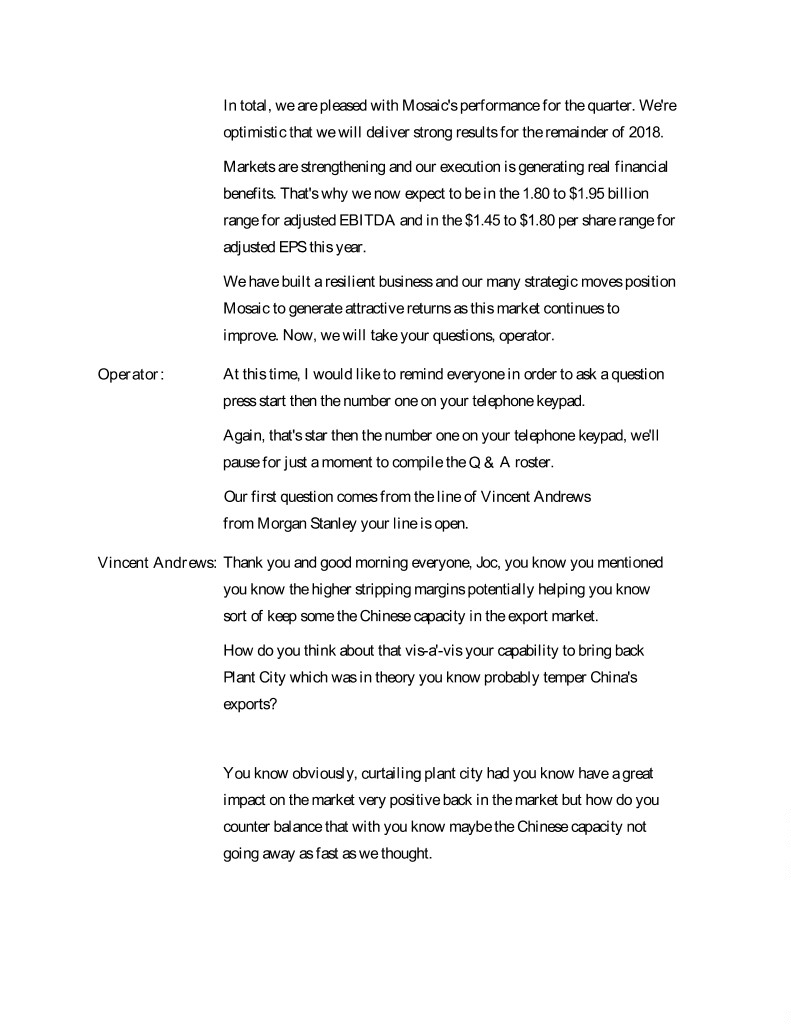
In total, we are pleased with Mosaic's performance for the quarter. We're optimistic that we will deliver strong results for the remainder of 2018. Markets are strengthening and our execution is generating real financial benefits. That's why we now expect to be in the 1.80 to $1.95 billion range for adjusted EBITDA and in the $1.45 to $1.80 per share range for adjusted EPS this year. We have built a resilient business and our many strategic moves position Mosaic to generate attractive returns as this market continues to improve. Now, we will take your questions, operator. Operator: At this time, I would like to remind everyone in order to ask a question press start then the number one on your telephone keypad. Again, that's star then the number one on your telephone keypad, we'll pause for just a moment to compile the Q & A roster. Our first question comes from the line of Vincent Andrews from Morgan Stanley your line is open. Vincent Andrews: Thank you and good morning everyone, Joc, you know you mentioned you know the higher stripping margins potentially helping you know sort of keep some the Chinese capacity in the export market. How do you think about that vis-a'-vis your capability to bring back Plant City which was in theory you know probably temper China's exports? You know obviously, curtailing plant city had you know have a great impact on the market very positive back in the market but how do you counter balance that with you know maybe the Chinese capacity not going away as fast as we thought.

Joc O'Rourke: Sure, good morning, Vincent good to hear from you. Well let me start by just giving you a little bit of our thoughts on Plant City and I'm going to hand it to Corrine to just talk a little bit about some of these changes in China. We do believe that with these higher prices the changes will occur a little slower. We'll see higher utilization of some of the better environmental performing plants and the less expensive plants but overall, I think we believe the trend is definitely that China will slowly decrease their exports. In terms of Plant City, the criteria for Plant City review has really not changed from last year. As you say, thinking behind idling Plant City in the first place came from expecting to offset some of the new production that was coming on. Clearly that new productions come on a little slower than we would have expected or might have been predicted but at the same time, we still fully expect that production will come on in the next couple of years. Some of that will be offset by growth in the market but we also believe some of that is offset by our own reduction in capacity. So with that, Corrine is there anything you want to say about the Chinese market. Corrine Ricard: Sure, you know we still are seeing a lot of discussion about the environmental protection mandate that we've seen around the Yangtze river. The situation is still evolving and our local team has been doing a lot of work to try and get updates for us regularly. They are reporting reduced rock production at some of the mines and increased costs related to the gypsum disposal and some producers are having real proximity challenges.
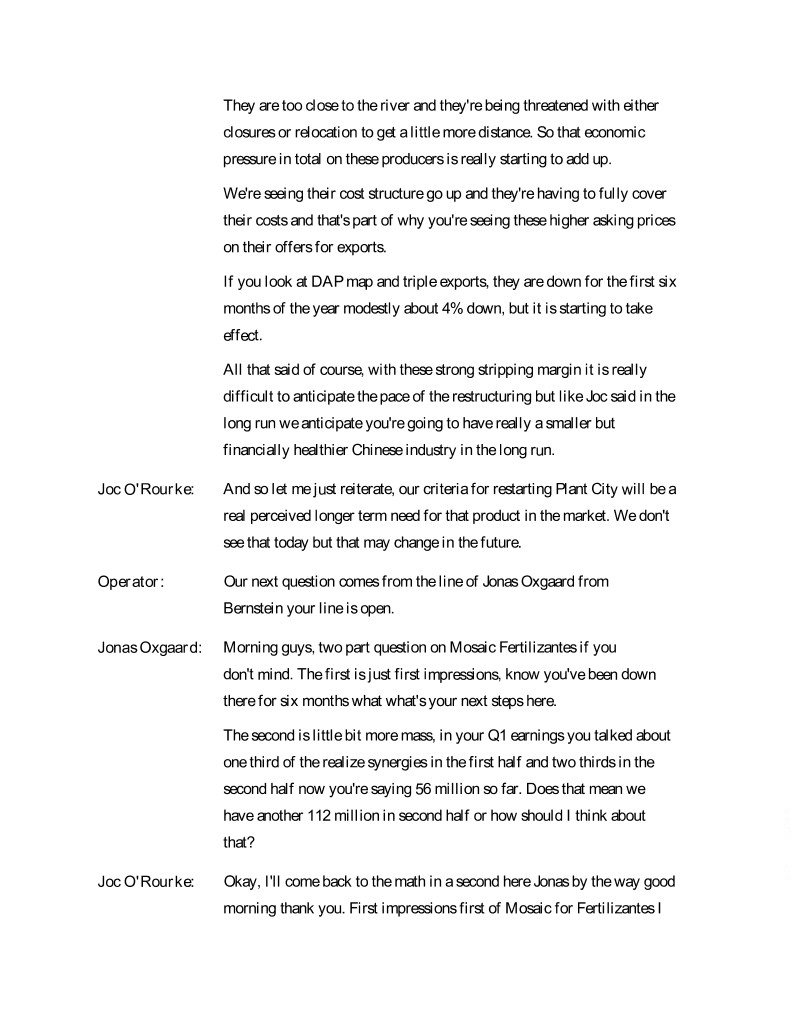
They are too close to the river and they're being threatened with either closures or relocation to get a little more distance. So that economic pressure in total on these producers is really starting to add up. We're seeing their cost structure go up and they're having to fully cover their costs and that's part of why you're seeing these higher asking prices on their offers for exports. If you look at DAP map and triple exports, they are down for the first six months of the year modestly about 4% down, but it is starting to take effect. All that said of course, with these strong stripping margin it is really difficult to anticipate the pace of the restructuring but like Joc said in the long run we anticipate you're going to have really a smaller but financially healthier Chinese industry in the long run. Joc O'Rourke: And so let me just reiterate, our criteria for restarting Plant City will be a real perceived longer term need for that product in the market. We don't see that today but that may change in the future. Operator: Our next question comes from the line of Jonas Oxgaard from Bernstein your line is open. Jonas Oxgaard: Morning guys, two part question on Mosaic Fertilizantes if you don't mind. The first is just first impressions, know you've been down there for six months what what's your next steps here. The second is little bit more mass, in your Q1 earnings you talked about one third of the realize synergies in the first half and two thirds in the second half now you're saying 56 million so far. Does that mean we have another 112 million in second half or how should I think about that? Joc O'Rourke: Okay, I'll come back to the math in a second here Jonas by the way good morning thank you. First impressions first of Mosaic for Fertilizantes I
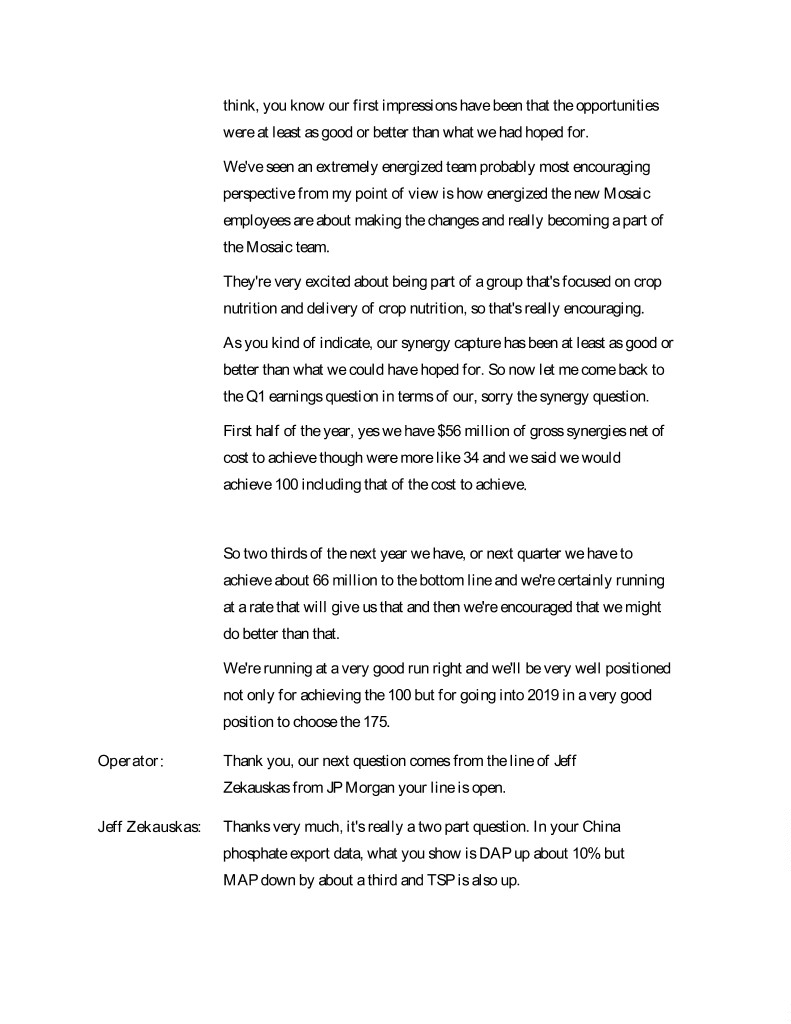
think, you know our first impressions have been that the opportunities were at least as good or better than what we had hoped for. We've seen an extremely energized team probably most encouraging perspective from my point of view is how energized the new Mosaic employees are about making the changes and really becoming a part of the Mosaic team. They're very excited about being part of a group that's focused on crop nutrition and delivery of crop nutrition, so that's really encouraging. As you kind of indicate, our synergy capture has been at least as good or better than what we could have hoped for. So now let me come back to the Q1 earnings question in terms of our, sorry the synergy question. First half of the year, yes we have $56 million of gross synergies net of cost to achieve though were more like 34 and we said we would achieve 100 including that of the cost to achieve. So two thirds of the next year we have, or next quarter we have to achieve about 66 million to the bottom line and we're certainly running at a rate that will give us that and then we're encouraged that we might do better than that. We're running at a very good run right and we'll be very well positioned not only for achieving the 100 but for going into 2019 in a very good position to choose the 175. Operator: Thank you, our next question comes from the line of Jeff Zekauskas from JP Morgan your line is open. Jeff Zekauskas: Thanks very much, it's really a two part question. In your China phosphate export data, what you show is DAP up about 10% but MAP down by about a third and TSP is also up.
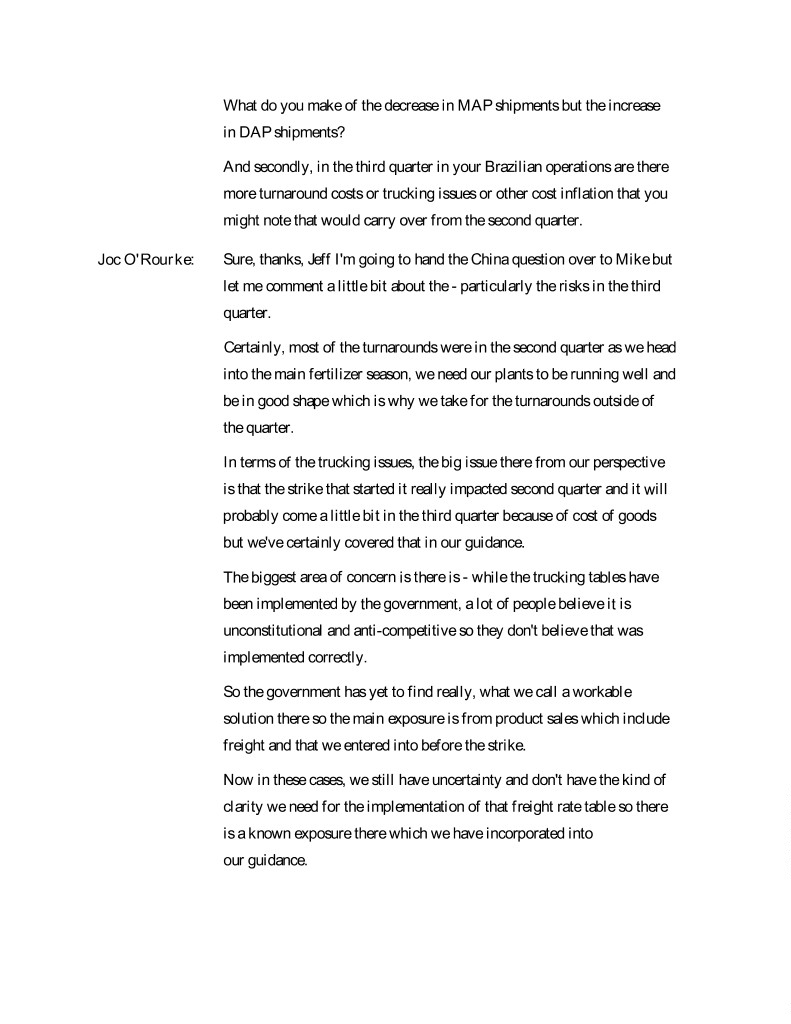
What do you make of the decrease in MAP shipments but the increase in DAP shipments? And secondly, in the third quarter in your Brazilian operations are there more turnaround costs or trucking issues or other cost inflation that you might note that would carry over from the second quarter. Joc O'Rourke: Sure, thanks, Jeff I'm going to hand the China question over to Mike but let me comment a little bit about the - particularly the risks in the third quarter. Certainly, most of the turnarounds were in the second quarter as we head into the main fertilizer season, we need our plants to be running well and be in good shape which is why we take for the turnarounds outside of the quarter. In terms of the trucking issues, the big issue there from our perspective is that the strike that started it really impacted second quarter and it will probably come a little bit in the third quarter because of cost of goods but we've certainly covered that in our guidance. The biggest area of concern is there is - while the trucking tables have been implemented by the government, a lot of people believe it is unconstitutional and anti-competitive so they don't believe that was implemented correctly. So the government has yet to find really, what we call a workable solution there so the main exposure is from product sales which include freight and that we entered into before the strike. Now in these cases, we still have uncertainty and don't have the kind of clarity we need for the implementation of that freight rate table so there is a known exposure there which we have incorporated into our guidance.
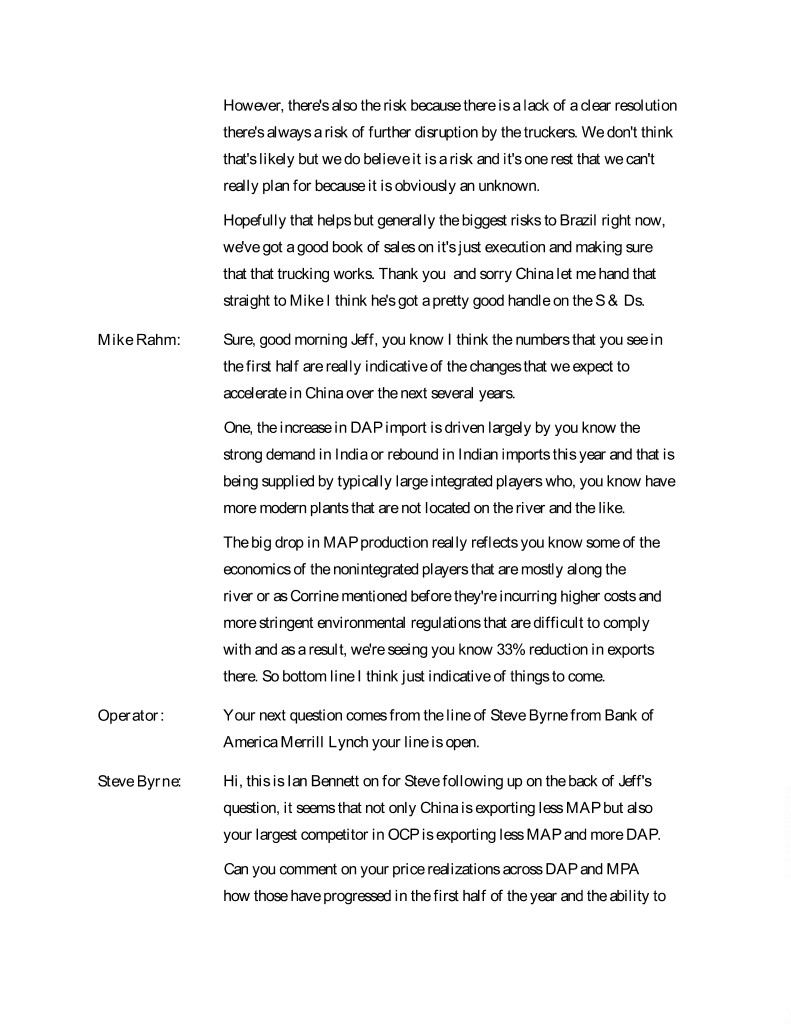
However, there's also the risk because there is a lack of a clear resolution there's always a risk of further disruption by the truckers. We don't think that's likely but we do believe it is a risk and it's one rest that we can't really plan for because it is obviously an unknown. Hopefully that helps but generally the biggest risks to Brazil right now, we've got a good book of sales on it's just execution and making sure that that trucking works. Thank you and sorry China let me hand that straight to Mike I think he's got a pretty good handle on the S & Ds. Mike Rahm: Sure, good morning Jeff, you know I think the numbers that you see in the first half are really indicative of the changes that we expect to accelerate in China over the next several years. One, the increase in DAP import is driven largely by you know the strong demand in India or rebound in Indian imports this year and that is being supplied by typically large integrated players who, you know have more modern plants that are not located on the river and the like. The big drop in MAP production really reflects you know some of the economics of the nonintegrated players that are mostly along the river or as Corrine mentioned before they're incurring higher costs and more stringent environmental regulations that are difficult to comply with and as a result, we're seeing you know 33% reduction in exports there. So bottom line I think just indicative of things to come. Operator: Your next question comes from the line of Steve Byrne from Bank of America Merrill Lynch your line is open. Steve Byrne: Hi, this is Ian Bennett on for Steve following up on the back of Jeff's question, it seems that not only China is exporting less MAP but also your largest competitor in OCP is exporting less MAP and more DAP. Can you comment on your price realizations across DAP and MPA how those have progressed in the first half of the year and the ability to
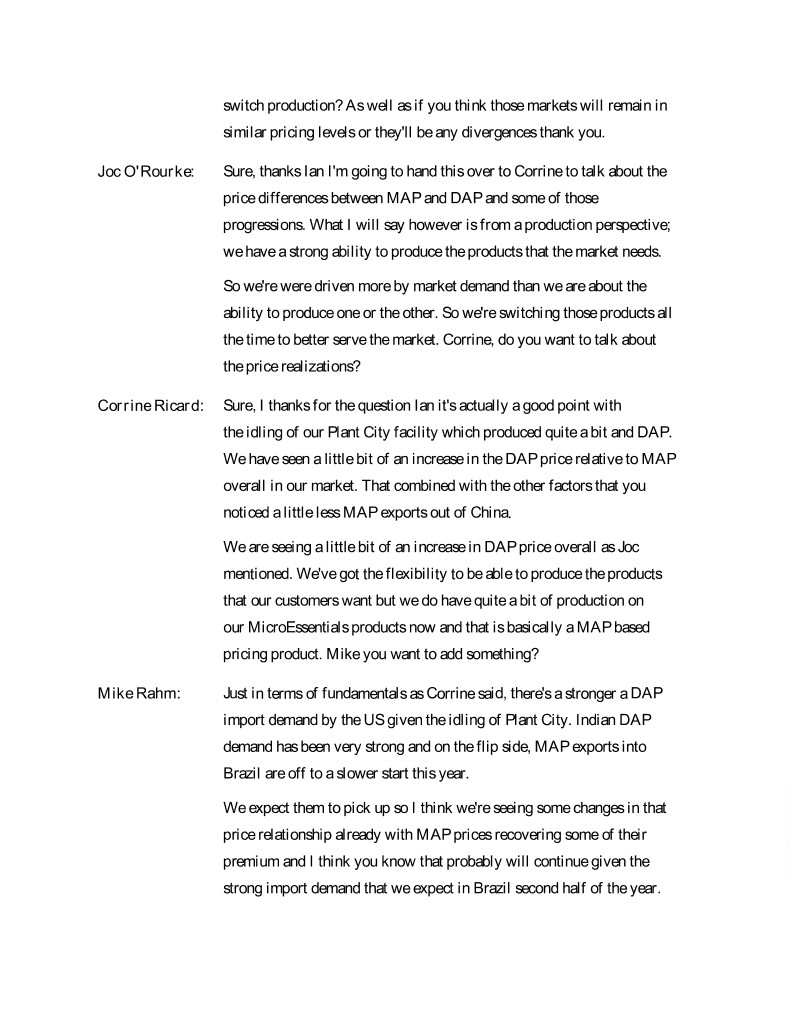
switch production? As well as if you think those markets will remain in similar pricing levels or they'll be any divergences thank you. Joc O'Rourke: Sure, thanks Ian I'm going to hand this over to Corrine to talk about the price differences between MAP and DAP and some of those progressions. What I will say however is from a production perspective; we have a strong ability to produce the products that the market needs. So we're were driven more by market demand than we are about the ability to produce one or the other. So we're switching those products all the time to better serve the market. Corrine, do you want to talk about the price realizations? Corrine Ricard: Sure, I thanks for the question Ian it's actually a good point with the idling of our Plant City facility which produced quite a bit and DAP. We have seen a little bit of an increase in the DAP price relative to MAP overall in our market. That combined with the other factors that you noticed a little less MAP exports out of China. We are seeing a little bit of an increase in DAP price overall as Joc mentioned. We've got the flexibility to be able to produce the products that our customers want but we do have quite a bit of production on our MicroEssentials products now and that is basically a MAP based pricing product. Mike you want to add something? Mike Rahm: Just in terms of fundamentals as Corrine said, there's a stronger a DAP import demand by the US given the idling of Plant City. Indian DAP demand has been very strong and on the flip side, MAP exports into Brazil are off to a slower start this year. We expect them to pick up so I think we're seeing some changes in that price relationship already with MAP prices recovering some of their premium and I think you know that probably will continue given the strong import demand that we expect in Brazil second half of the year.
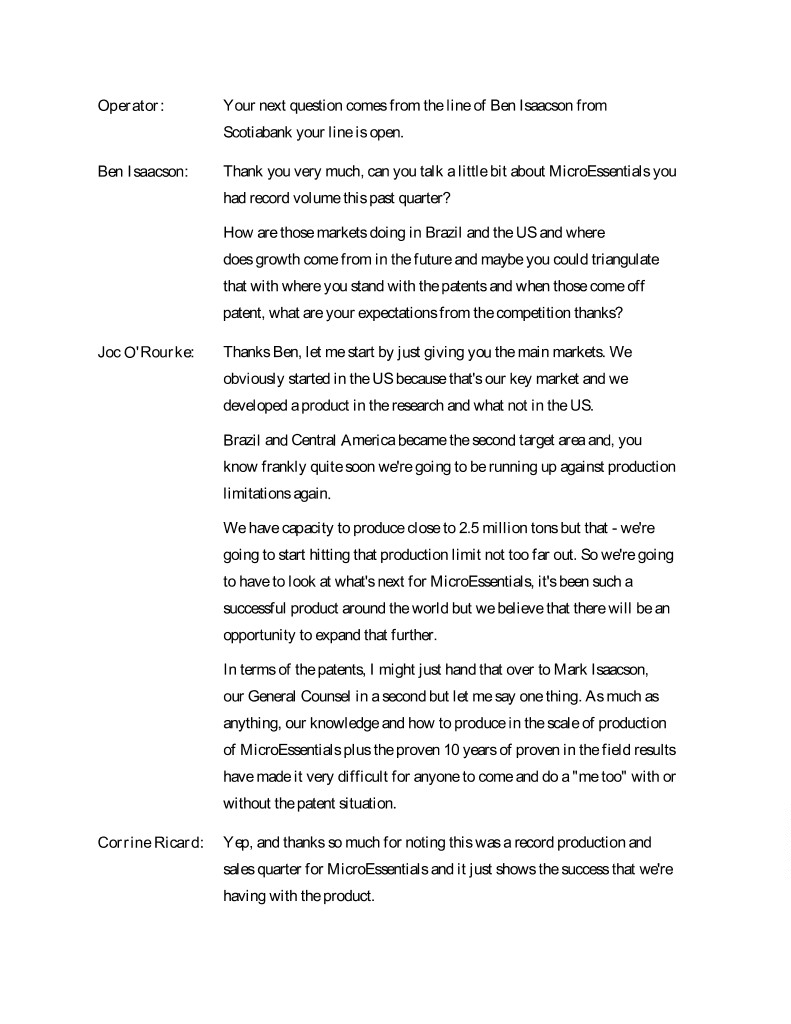
Operator: Your next question comes from the line of Ben Isaacson from Scotiabank your line is open. Ben Isaacson: Thank you very much, can you talk a little bit about MicroEssentials you had record volume this past quarter? How are those markets doing in Brazil and the US and where does growth come from in the future and maybe you could triangulate that with where you stand with the patents and when those come off patent, what are your expectations from the competition thanks? Joc O'Rourke: Thanks Ben, let me start by just giving you the main markets. We obviously started in the US because that's our key market and we developed a product in the research and what not in the US. Brazil and Central America became the second target area and, you know frankly quite soon we're going to be running up against production limitations again. We have capacity to produce close to 2.5 million tons but that - we're going to start hitting that production limit not too far out. So we're going to have to look at what's next for MicroEssentials, it's been such a successful product around the world but we believe that there will be an opportunity to expand that further. In terms of the patents, I might just hand that over to Mark Isaacson, our General Counsel in a second but let me say one thing. As much as anything, our knowledge and how to produce in the scale of production of MicroEssentials plus the proven 10 years of proven in the field results have made it very difficult for anyone to come and do a "me too" with or without the patent situation. Corrine Ricard: Yep, and thanks so much for noting this was a record production and sales quarter for MicroEssentials and it just shows the success that we're having with the product.

Overall, pricing has been maintained at the levels relative to MAP in all of our markets and demand has been strong and growing as Joc says we're going to have to start to think about the further growth from there in production. And in terms of the patent, I'll turn over to Mark Isaacson. Mark Isaacson: Right even though the primary MicroEssentials patent will be expiring in a few years here, we also have improvements have been made to that product that we'll be filing patents for and that we have already. And as Joc mentioned really much of the MicroEssentials technology is in trade secrets and in operating knowledge that allow us to make them into quantities and the quality that we can. Operator: Your next question comes from the line of Don Carson from Susquehanna your line is open. Don Carson: Yes, thank you question for Michael you know on slide 17 and18 you outline your demand expectations for P & K. What do you see on the supply side? How do you see operating reach globally unfolding as we go through '18 into '19 and then some of this new capacity starts up and then just as a follow up on Brazil, what's the overall impact of rising freight rates? Does that affect you more as a domestic producer or does it create a higher price umbrella because it'll lead to higher freight costs on a relative basis for imports of phosphate into Brazil? Joc O'Rourke: Mike, you go ahead and give the first part to that please Mike Rahm: Okay, yeah Don thanks for the question good morning you know if you look at those charts, there's certainly a very good demand story unfolding.

You know I should note that we have revised up our shipment estimates for the past couple of years based on you know a new trade information from various sources including the international fertilizer association. And when you look at our projections for 2019, you know they are - they do reflect a bit more modest growth from a much higher base and I would emphasize that those are our initial forecasts. We'll see how demand plays out in particular how agricultural commodity prices move. You know, we've seen a big drop off in June but they are rebounding very nicely given a much smaller global crop than what was anticipated especially for wheat. When you lay that up against increases in capacity in the case of phosphates, you know we basically see a deficit in 2018. First half, we think that deficit was close to half of million tons you know for the year it could be in that 700 to million ton range and what we've said in the past several earnings calls is that, you know we're not saying the world is going to run out of phosphate. All we're saying is that prices and margins need to probably increase as they have to levels that maybe trim a little bit of demand and also stimulate a little bit more supply from various sources. And for 2019, when we look at those changes given what we think will be a significant reduction and exports from China next year. You know we think that a deficit situation likely will continue well into 2019 even with the continued ramp up of the additional capacity and the same really holds true for potash as well. You know, there are some puts and takes obviously on the supply side with some facilities winding down production and others you know ramping up but the bottom line is we see a balanced to tight situation in the global potash market through at least the end of next year.
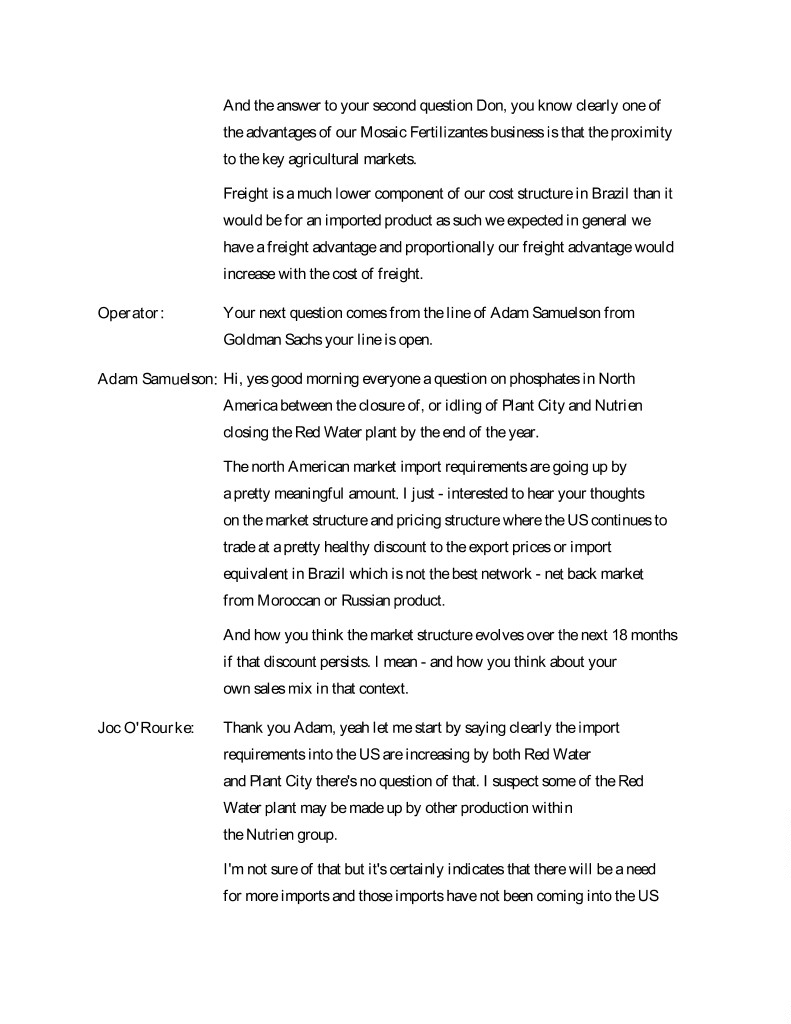
And the answer to your second question Don, you know clearly one of the advantages of our Mosaic Fertilizantes business is that the proximity to the key agricultural markets. Freight is a much lower component of our cost structure in Brazil than it would be for an imported product as such we expected in general we have a freight advantage and proportionally our freight advantage would increase with the cost of freight. Operator: Your next question comes from the line of Adam Samuelson from Goldman Sachs your line is open. Adam Samuelson: Hi, yes good morning everyone a question on phosphates in North America between the closure of, or idling of Plant City and Nutrien closing the Red Water plant by the end of the year. The north American market import requirements are going up by a pretty meaningful amount. I just - interested to hear your thoughts on the market structure and pricing structure where the US continues to trade at a pretty healthy discount to the export prices or import equivalent in Brazil which is not the best network - net back market from Moroccan or Russian product. And how you think the market structure evolves over the next 18 months if that discount persists. I mean - and how you think about your own sales mix in that context. Joc O'Rourke: Thank you Adam, yeah let me start by saying clearly the import requirements into the US are increasing by both Red Water and Plant City there's no question of that. I suspect some of the Red Water plant may be made up by other production within the Nutrien group. I'm not sure of that but it's certainly indicates that there will be a need for more imports and those imports have not been coming into the US
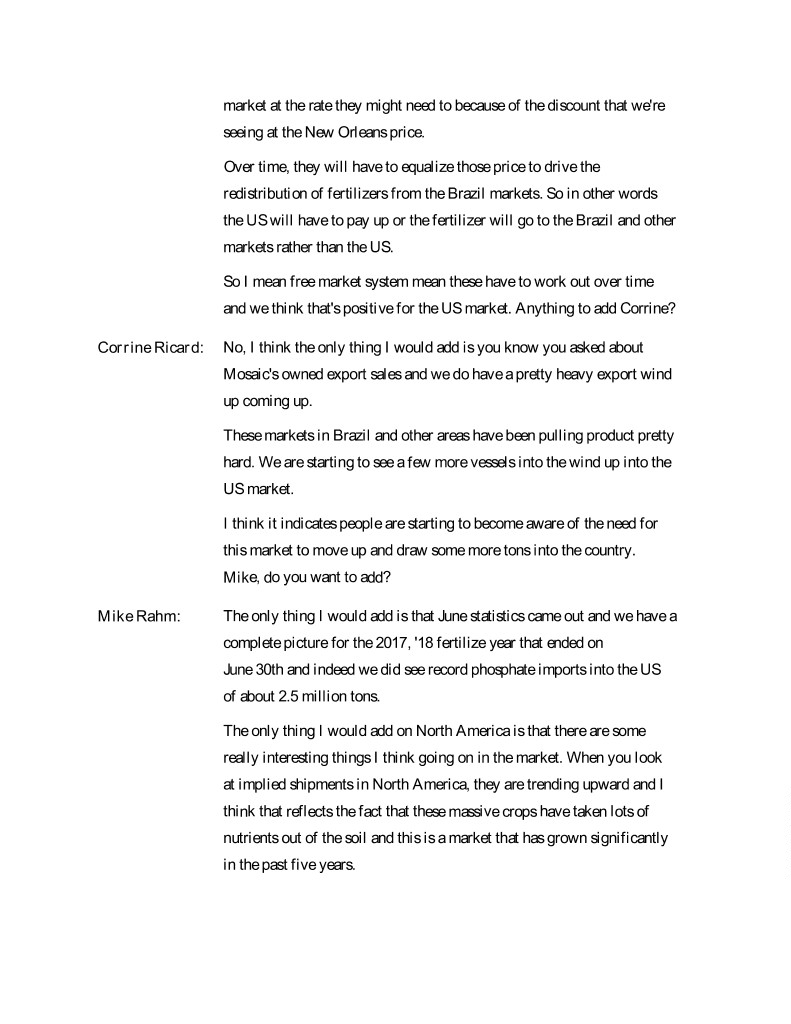
market at the rate they might need to because of the discount that we're seeing at the New Orleans price. Over time, they will have to equalize those price to drive the redistribution of fertilizers from the Brazil markets. So in other words the US will have to pay up or the fertilizer will go to the Brazil and other markets rather than the US. So I mean free market system mean these have to work out over time and we think that's positive for the US market. Anything to add Corrine? Corrine Ricard: No, I think the only thing I would add is you know you asked about Mosaic's owned export sales and we do have a pretty heavy export wind up coming up. These markets in Brazil and other areas have been pulling product pretty hard. We are starting to see a few more vessels into the wind up into the US market. I think it indicates people are starting to become aware of the need for this market to move up and draw some more tons into the country. Mike, do you want to add? Mike Rahm: The only thing I would add is that June statistics came out and we have a complete picture for the 2017, '18 fertilize year that ended on June 30th and indeed we did see record phosphate imports into the US of about 2.5 million tons. The only thing I would add on North America is that there are some really interesting things I think going on in the market. When you look at implied shipments in North America, they are trending upward and I think that reflects the fact that these massive crops have taken lots of nutrients out of the soil and this is a market that has grown significantly in the past five years.
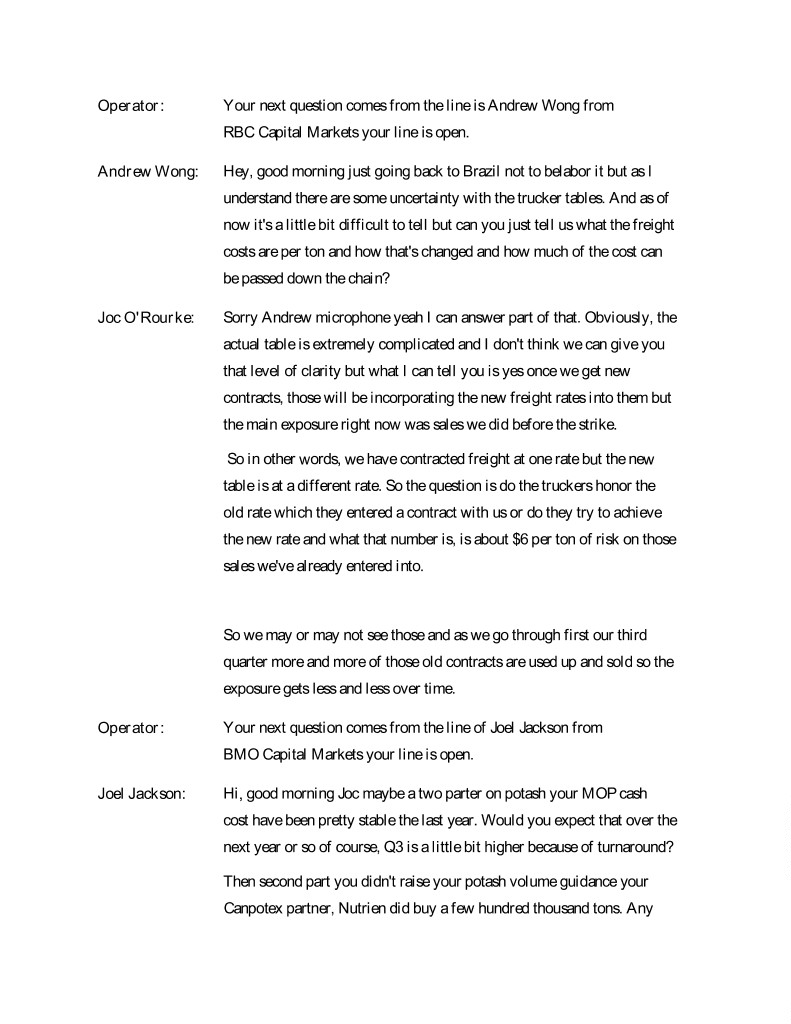
Operator: Your next question comes from the line is Andrew Wong from RBC Capital Markets your line is open. Andrew Wong: Hey, good morning just going back to Brazil not to belabor it but as I understand there are some uncertainty with the trucker tables. And as of now it's a little bit difficult to tell but can you just tell us what the freight costs are per ton and how that's changed and how much of the cost can be passed down the chain? Joc O'Rourke: Sorry Andrew microphone yeah I can answer part of that. Obviously, the actual table is extremely complicated and I don't think we can give you that level of clarity but what I can tell you is yes once we get new contracts, those will be incorporating the new freight rates into them but the main exposure right now was sales we did before the strike. So in other words, we have contracted freight at one rate but the new table is at a different rate. So the question is do the truckers honor the old rate which they entered a contract with us or do they try to achieve the new rate and what that number is, is about $6 per ton of risk on those sales we've already entered into. So we may or may not see those and as we go through first our third quarter more and more of those old contracts are used up and sold so the exposure gets less and less over time. Operator: Your next question comes from the line of Joel Jackson from BMO Capital Markets your line is open. Joel Jackson: Hi, good morning Joc maybe a two parter on potash your MOP cash cost have been pretty stable the last year. Would you expect that over the next year or so of course, Q3 is a little bit higher because of turnaround? Then second part you didn't raise your potash volume guidance your Canpotex partner, Nutrien did buy a few hundred thousand tons. Any
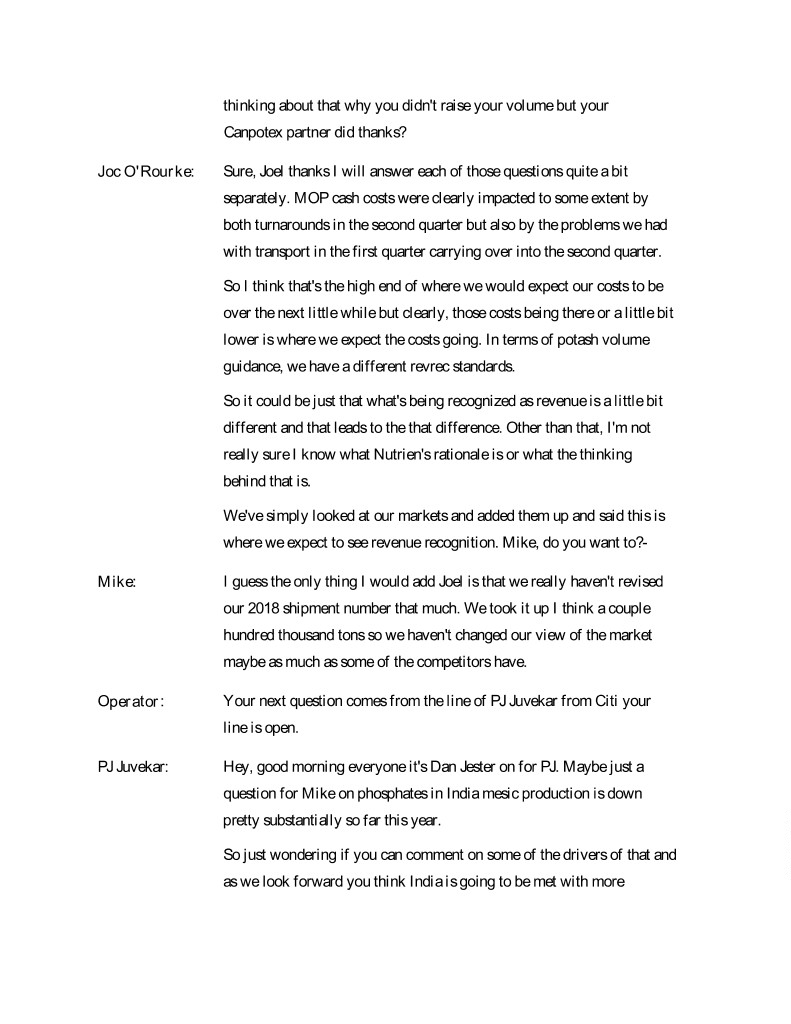
thinking about that why you didn't raise your volume but your Canpotex partner did thanks? Joc O'Rourke: Sure, Joel thanks I will answer each of those questions quite a bit separately. MOP cash costs were clearly impacted to some extent by both turnarounds in the second quarter but also by the problems we had with transport in the first quarter carrying over into the second quarter. So I think that's the high end of where we would expect our costs to be over the next little while but clearly, those costs being there or a little bit lower is where we expect the costs going. In terms of potash volume guidance, we have a different revrec standards. So it could be just that what's being recognized as revenue is a little bit different and that leads to the that difference. Other than that, I'm not really sure I know what Nutrien's rationale is or what the thinking behind that is. We've simply looked at our markets and added them up and said this is where we expect to see revenue recognition. Mike, do you want to?- Mike: I guess the only thing I would add Joel is that we really haven't revised our 2018 shipment number that much. We took it up I think a couple hundred thousand tons so we haven't changed our view of the market maybe as much as some of the competitors have. Operator: Your next question comes from the line of PJ Juvekar from Citi your line is open. PJ Juvekar: Hey, good morning everyone it's Dan Jester on for PJ. Maybe just a question for Mike on phosphates in India mesic production is down pretty substantially so far this year. So just wondering if you can comment on some of the drivers of that and as we look forward you think India is going to be met with more
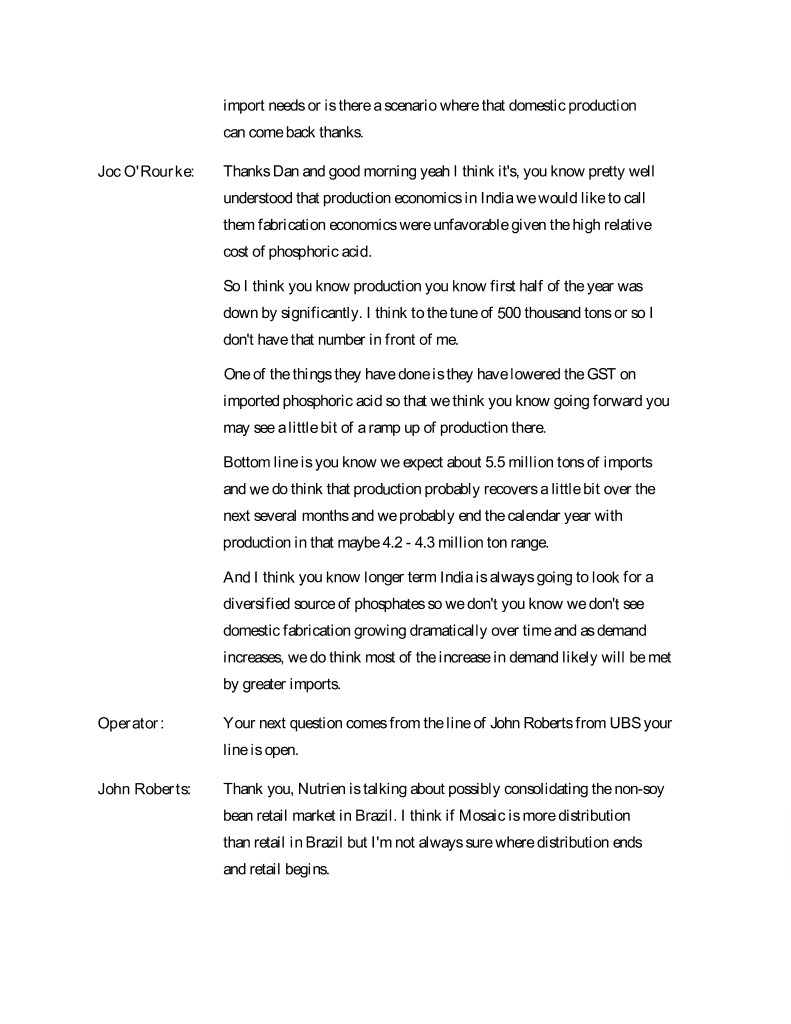
import needs or is there a scenario where that domestic production can come back thanks. Joc O'Rourke: Thanks Dan and good morning yeah I think it's, you know pretty well understood that production economics in India we would like to call them fabrication economics were unfavorable given the high relative cost of phosphoric acid. So I think you know production you know first half of the year was down by significantly. I think to the tune of 500 thousand tons or so I don't have that number in front of me. One of the things they have done is they have lowered the GST on imported phosphoric acid so that we think you know going forward you may see a little bit of a ramp up of production there. Bottom line is you know we expect about 5.5 million tons of imports and we do think that production probably recovers a little bit over the next several months and we probably end the calendar year with production in that maybe 4.2 - 4.3 million ton range. And I think you know longer term India is always going to look for a diversified source of phosphates so we don't you know we don't see domestic fabrication growing dramatically over time and as demand increases, we do think most of the increase in demand likely will be met by greater imports. Operator: Your next question comes from the line of John Roberts from UBS your line is open. John Roberts: Thank you, Nutrien is talking about possibly consolidating the non-soy bean retail market in Brazil. I think if Mosaic is more distribution than retail in Brazil but I'm not always sure where distribution ends and retail begins.

Do you have any parts of your network that might be non-core or on the other side does your balance sheet even allow you to participate in any further consolidation if you wanted to? Joc O'Rourke: Hello John, thanks for that, the structure of the Brazil business or the Brazil market is quite a bit different than what I would call the north American retail. So as you say, it's kind of hard to determine what is retail and what is distribution. We sell to a lot of very large farmers but we also sell into some smaller retails it's a very fragmented type of industry there and again, I can't comment on what our competitors are doing or thinking. What I would say though is you know we believe we've built a very good competitive business in Brazil. We believe the synergies between our distribution business and our production business gives us a real competitive advantage and a real first mover advantage into those core markets. And the other models for that, we'll just wait and see and see how they work and we'll obviously respond to what that means to the competitive landscape, thanks. Operator: Your next question comes from the line of Michael Piken from Cleveland Research your line is open. Michael Piken: Yeah, hi I'm just wondering if you guys could give us a little bit more - I know you said you going to talk more about K3 on your next call but you know just talk about kind of where you see yourself on a cash cost per ton for potash. And then follow up would be just any updates on when we might see India or China settle a potash contract. Joc O'Rourke: Thanks Michael, yeah on K3 let me give you an update on where we're at and we will talk more about this in future calls. And the reason we
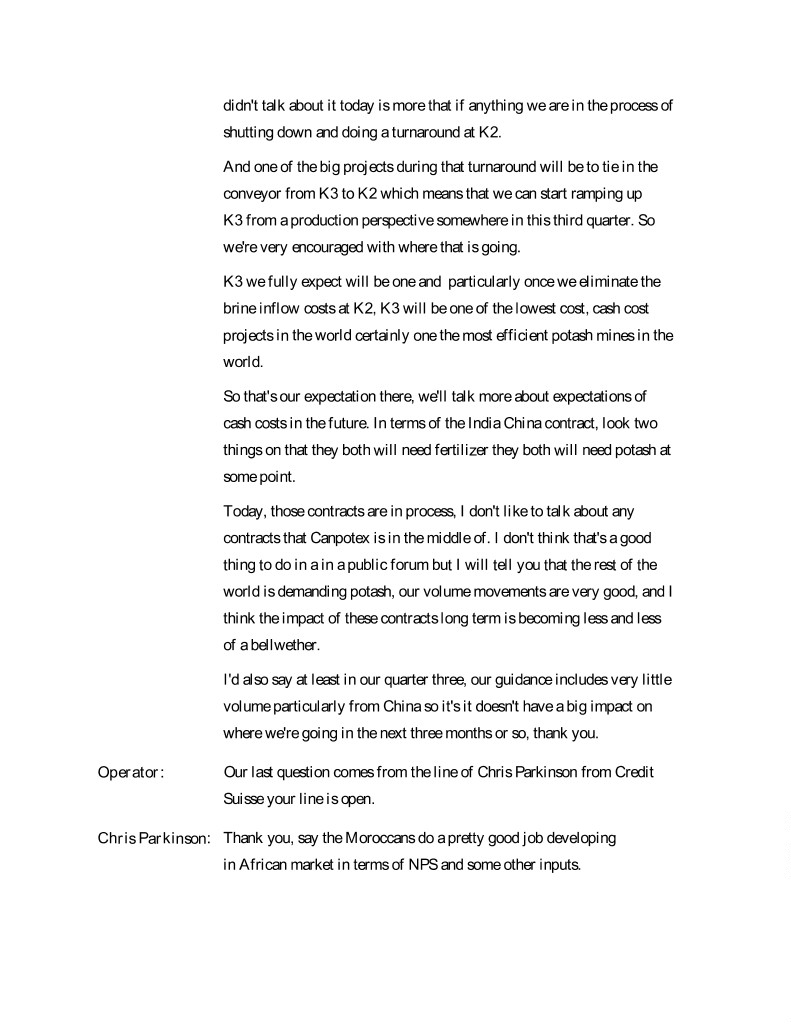
didn't talk about it today is more that if anything we are in the process of shutting down and doing a turnaround at K2. And one of the big projects during that turnaround will be to tie in the conveyor from K3 to K2 which means that we can start ramping up K3 from a production perspective somewhere in this third quarter. So we're very encouraged with where that is going. K3 we fully expect will be one and particularly once we eliminate the brine inflow costs at K2, K3 will be one of the lowest cost, cash cost projects in the world certainly one the most efficient potash mines in the world. So that's our expectation there, we'll talk more about expectations of cash costs in the future. In terms of the India China contract, look two things on that they both will need fertilizer they both will need potash at some point. Today, those contracts are in process, I don't like to talk about any contracts that Canpotex is in the middle of. I don't think that's a good thing to do in a in a public forum but I will tell you that the rest of the world is demanding potash, our volume movements are very good, and I think the impact of these contracts long term is becoming less and less of a bellwether. I'd also say at least in our quarter three, our guidance includes very little volume particularly from China so it's it doesn't have a big impact on where we're going in the next three months or so, thank you. Operator: Our last question comes from the line of Chris Parkinson from Credit Suisse your line is open. Chris Parkinson: Thank you, say the Moroccans do a pretty good job developing in African market in terms of NPS and some other inputs.

On this front, can you just talk about MicroEssentials current spread verses DAP MAP and then also give us a sense of any of your other longer term agronomic development efforts specifically on the P front and anything in LATAM and India in particular thank you. Joc O'Rourke: Okay, thanks Chris yeah would concur that - I mean from the outside looking in OCP has done a very good job of developing the African market and you know I think that's great for society overall. So we're pleased to see both the development of the market and the contribution to Africa in general. So we're glad to see that you know obviously our our MicroEssentials products go to somewhat different markets. In terms of the spread over DAP and MAP, there's really two pieces to that and I'm going to let Corrine talk about this a bit but we maintain a price relative to MAP and that has a constant premium in some cases that has not changed. But then, when we also make part of our increased margin is because the inputs into MicroEssentials are different than the inputs into DAP and MA. So the cost structure is more favorable for our MicroEssentials product is basically the thing. So you can't just look at price but you will see over time a price premium for the MicroEssentials products particularly in markets like Brazil. Corrine do you want to follow that on? Corrine Ricard: Sure, you know when we talk about MicroEssentials, there are a number of different products within that group of products, and so we've got different pricing for each one of those relative to the micronutrients, the sulfur content, etcetera.
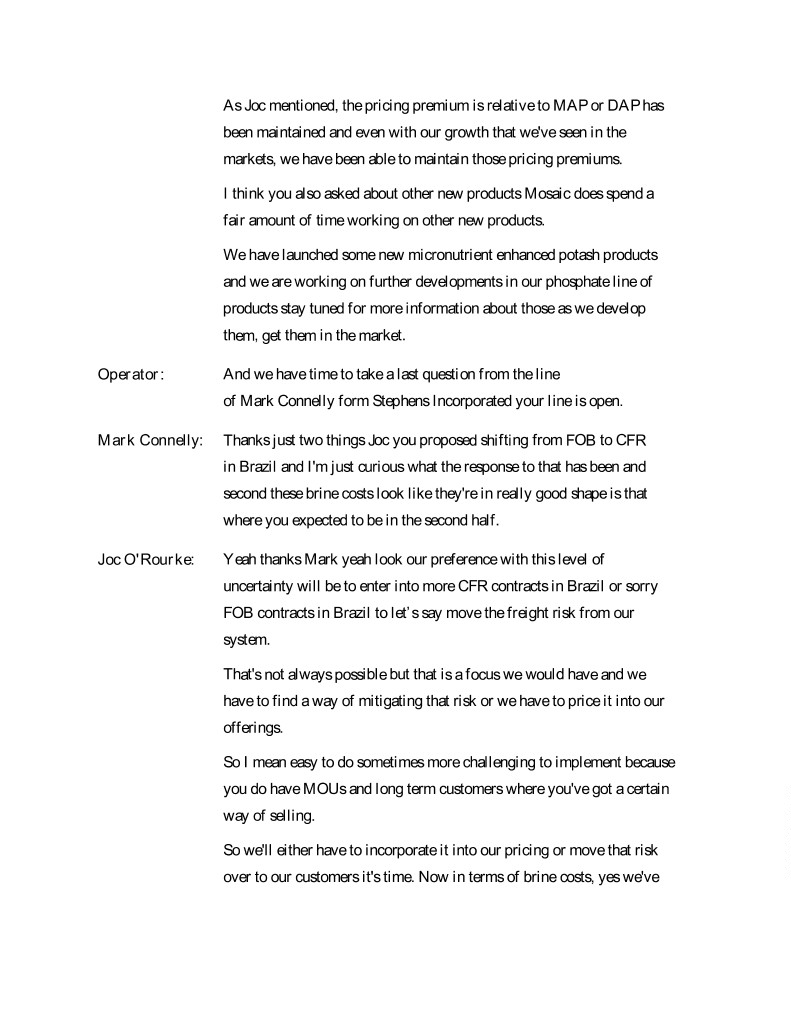
As Joc mentioned, the pricing premium is relative to MAP or DAP has been maintained and even with our growth that we've seen in the markets, we have been able to maintain those pricing premiums. I think you also asked about other new products Mosaic does spend a fair amount of time working on other new products. We have launched some new micronutrient enhanced potash products and we are working on further developments in our phosphate line of products stay tuned for more information about those as we develop them, get them in the market. Operator: And we have time to take a last question from the line of Mark Connelly form Stephens Incorporated your line is open. Mark Connelly: Thanks just two things Joc you proposed shifting from FOB to CFR in Brazil and I'm just curious what the response to that has been and second these brine costs look like they're in really good shape is that where you expected to be in the second half. Joc O'Rourke: Yeah thanks Mark yeah look our preference with this level of uncertainty will be to enter into more CFR contracts in Brazil or sorry FOB contracts in Brazil to let’s say move the freight risk from our system. That's not always possible but that is a focus we would have and we have to find a way of mitigating that risk or we have to price it into our offerings. So I mean easy to do sometimes more challenging to implement because you do have MOUs and long term customers where you've got a certain way of selling. So we'll either have to incorporate it into our pricing or move that risk over to our customers it's time. Now in terms of brine costs, yes we've
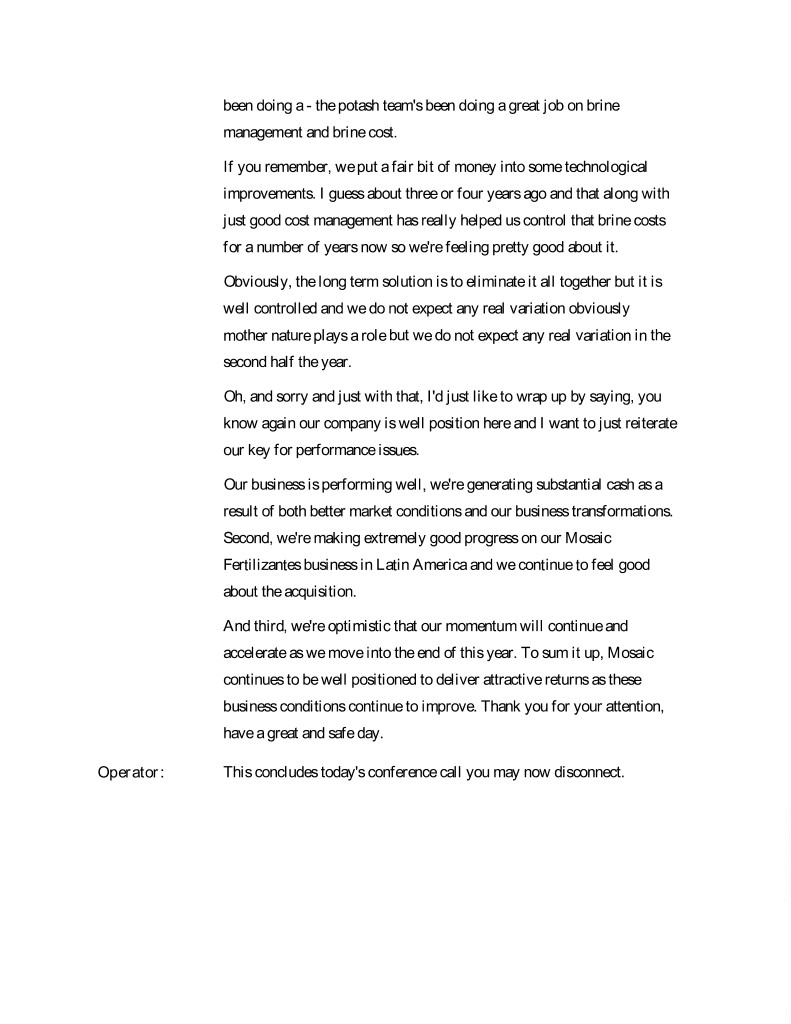
been doing a - the potash team's been doing a great job on brine management and brine cost. If you remember, we put a fair bit of money into some technological improvements. I guess about three or four years ago and that along with just good cost management has really helped us control that brine costs for a number of years now so we're feeling pretty good about it. Obviously, the long term solution is to eliminate it all together but it is well controlled and we do not expect any real variation obviously mother nature plays a role but we do not expect any real variation in the second half the year. Oh, and sorry and just with that, I'd just like to wrap up by saying, you know again our company is well position here and I want to just reiterate our key for performance issues. Our business is performing well, we're generating substantial cash as a result of both better market conditions and our business transformations. Second, we're making extremely good progress on our Mosaic Fertilizantes business in Latin America and we continue to feel good about the acquisition. And third, we're optimistic that our momentum will continue and accelerate as we move into the end of this year. To sum it up, Mosaic continues to be well positioned to deliver attractive returns as these business conditions continue to improve. Thank you for your attention, have a great and safe day. Operator: This concludes today's conference call you may now disconnect.


























